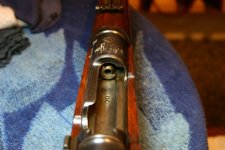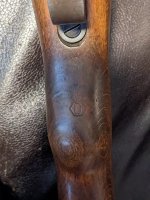krukster86
Well-known member
This is my latest Polish rifle, a 1933 dated FB Radom Kbk.S.Wz.31 (Karabinek “Sportowy” Wzor 1931, or “Sporting Short Rifle Model 1931”), which is a .22lr trainer, stylized like the Wz.29 short rifle of the era in use with the Polish Military. These are exceedingly rare to find in the US, as I have personally only seen one come up for sale in my comparatively short collecting hobby. These trainers are very briefly mentioned in a few books and Internet articles, though I found a small morsel of decent information from some Polish language resources, which I will do my best to summarize (though I am open to corrections if someone has additional information).
After Poland gained its independence after WWI, there was immediately a need to develop its military and train its new recruits accordingly. At first, there were no specific “training” rifles on hand, and trainees primarily used shotguns for introductory firearms training at short distances before they moved onto use of the standard issue military rifles. There was a growing need to have a dedicated “training rifle” in a low caliber for use with trainees to get them used to shooting and fundamentals before moving onto full size military rifles. The Polish military and the domestic arms developers started to do research into what other countries were doing at the time for trainers.
The first iteration of military “trainers” were not purpose built training rifles like the KKW .22lr trainers in Nazi Germany, but modified/rechambered battle rifles. These were Karabinek Wz. 1898 (Polish K98) carbines that were converted to .22lr barrels, had their Mauser 98 bolts extensively modified to .22lr rimfire, and had their magazines deactivated to single shot only. From an outward appearance with the bolt closed, these are virtually identical to a regular Polish K98, but had a large “22” added to the handguard to prevent misfeeding the wrong ammunition. I have only come across one resource for this, but these appear to have been designated the Kbk.S.Wz.29.
The second iteration of a military training rifle was this rifle, the Kbk.S.Wz.31. It was designed from the ground up as a purpose-made .22lr trainer and not adapted/converted from an existing rifle. It was designed to mimic the look and feel of the Wz.29 short rifle. These trainers were produced by FB Radom exclusively from 1932 to 1939, but I have no idea what the production figures were, as this documentation was probably lost during World War II.
Compared to a normal Wz.29, this trainer does have a simplified bolt that is not of a Mauser 98 design, but rather very similar to the design of the post-war Wz.48 Mosin Nagant .22lr trainer. It does not have an extractor/ejector built into the bolt, but is rather that is accomplished via a sliding part that slides in the feed tray when the bolt is opened/closed, and pulls out and ejects the spent case when the bolt is pulled back. It is single shot only, as evidenced by the lack of an internal magazine as part of the triggerguard. It has a simplified rear sight ladder, with one set of numbers ranging from 2-10, corresponding to a distance of 20 to 100 meters. It has a fully functional bayonet lug, so I would assume that it could be used for bayonet training. These were not actually blued, like the other military Mausers, but zinc parkerized with enamel black paint applied on top. This example still has some of the original paint near the woodline, but otherwise the exterior metal has that enamel paint rubbed off, and the surface finish has turned into patina.
The trigger is a two stage Mauser trigger, but with a very simple tension bar mechanism for the “spring”.
The receiver itself seems to be manufactured from a cylinder/tube rather than the fine machining of a Mauser 98 receiver. The handguard retaining lip wraps around the entire circumference of the receiver rather than just half like on a Wz.29.
This particular example was able to be affordable for me for a couple of reasons. The stock is duffel cut, which means it was likely a USGI bring back. I am most likely not going to repair the duffel cut, as part of the history (and I am pretty sure the recoil of .22lr is not going to blow it out when shooting). A retaining screw in the bolt is missing, but it doesn’t impact the function or operation. I can probably source a replacement equivalent pignose head screw from McMaster Carr based on some photos of complete examples. I spoke with Battlefield Curator (on YouTube) and his buddy that has one of these is missing that screw as well, and it runs just fine without it. The stock clearly has been sanded, as it has some rounded curvature to some features that should be “sharp”, and the Polish proofs on the wood at the wrist and butt are only barely outlined when I shine the light just right. I did notice that the front barrel band spring is snapped, which should be easy to fix/replace, as this is a component shared with many Mauser 98 pattern rifles. These factors did help in bringing down the price SIGNIFICANTLY compared to some “legacy” searches of closing bids at auction and boutique milsurp sellers. The rarity kinda comes into play here, so yeah it is a little bit “off” and not ideal, but it isn’t like you can check back on GunBroker next month and find another let alone replacement parts.
The following parts are matching: receiver, rear sight ladder, buttplate, ejector/extractor, and bolt body.
The following parts are not serialized, but have either “Polish Lucky Charms” or inspector markings: Trigger assembly, bayonet lug, rear sling swivel, sling bar, rear sight spring, front sight.
The following parts appear to be mismatched: handguard (handwritten T105), barrel is simply stamped “17” with some random small proofmarks, and the rear sight base is stamped “23”.
Curiously, the stock (wood) itself doesn’t appear to be serialized.
All in all, I am extremely happy to have this in my Polish collection and plan to have my son shoot this as his a first firearm, once he is old enough.



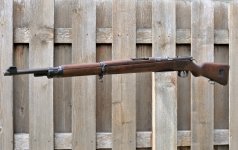

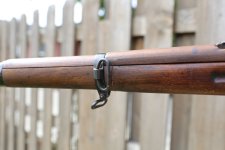
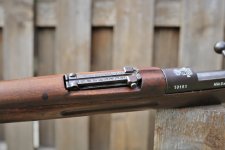
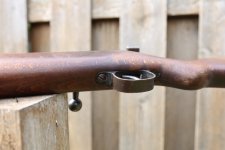


After Poland gained its independence after WWI, there was immediately a need to develop its military and train its new recruits accordingly. At first, there were no specific “training” rifles on hand, and trainees primarily used shotguns for introductory firearms training at short distances before they moved onto use of the standard issue military rifles. There was a growing need to have a dedicated “training rifle” in a low caliber for use with trainees to get them used to shooting and fundamentals before moving onto full size military rifles. The Polish military and the domestic arms developers started to do research into what other countries were doing at the time for trainers.
The first iteration of military “trainers” were not purpose built training rifles like the KKW .22lr trainers in Nazi Germany, but modified/rechambered battle rifles. These were Karabinek Wz. 1898 (Polish K98) carbines that were converted to .22lr barrels, had their Mauser 98 bolts extensively modified to .22lr rimfire, and had their magazines deactivated to single shot only. From an outward appearance with the bolt closed, these are virtually identical to a regular Polish K98, but had a large “22” added to the handguard to prevent misfeeding the wrong ammunition. I have only come across one resource for this, but these appear to have been designated the Kbk.S.Wz.29.
The second iteration of a military training rifle was this rifle, the Kbk.S.Wz.31. It was designed from the ground up as a purpose-made .22lr trainer and not adapted/converted from an existing rifle. It was designed to mimic the look and feel of the Wz.29 short rifle. These trainers were produced by FB Radom exclusively from 1932 to 1939, but I have no idea what the production figures were, as this documentation was probably lost during World War II.
Compared to a normal Wz.29, this trainer does have a simplified bolt that is not of a Mauser 98 design, but rather very similar to the design of the post-war Wz.48 Mosin Nagant .22lr trainer. It does not have an extractor/ejector built into the bolt, but is rather that is accomplished via a sliding part that slides in the feed tray when the bolt is opened/closed, and pulls out and ejects the spent case when the bolt is pulled back. It is single shot only, as evidenced by the lack of an internal magazine as part of the triggerguard. It has a simplified rear sight ladder, with one set of numbers ranging from 2-10, corresponding to a distance of 20 to 100 meters. It has a fully functional bayonet lug, so I would assume that it could be used for bayonet training. These were not actually blued, like the other military Mausers, but zinc parkerized with enamel black paint applied on top. This example still has some of the original paint near the woodline, but otherwise the exterior metal has that enamel paint rubbed off, and the surface finish has turned into patina.
The trigger is a two stage Mauser trigger, but with a very simple tension bar mechanism for the “spring”.
The receiver itself seems to be manufactured from a cylinder/tube rather than the fine machining of a Mauser 98 receiver. The handguard retaining lip wraps around the entire circumference of the receiver rather than just half like on a Wz.29.
This particular example was able to be affordable for me for a couple of reasons. The stock is duffel cut, which means it was likely a USGI bring back. I am most likely not going to repair the duffel cut, as part of the history (and I am pretty sure the recoil of .22lr is not going to blow it out when shooting). A retaining screw in the bolt is missing, but it doesn’t impact the function or operation. I can probably source a replacement equivalent pignose head screw from McMaster Carr based on some photos of complete examples. I spoke with Battlefield Curator (on YouTube) and his buddy that has one of these is missing that screw as well, and it runs just fine without it. The stock clearly has been sanded, as it has some rounded curvature to some features that should be “sharp”, and the Polish proofs on the wood at the wrist and butt are only barely outlined when I shine the light just right. I did notice that the front barrel band spring is snapped, which should be easy to fix/replace, as this is a component shared with many Mauser 98 pattern rifles. These factors did help in bringing down the price SIGNIFICANTLY compared to some “legacy” searches of closing bids at auction and boutique milsurp sellers. The rarity kinda comes into play here, so yeah it is a little bit “off” and not ideal, but it isn’t like you can check back on GunBroker next month and find another let alone replacement parts.
The following parts are matching: receiver, rear sight ladder, buttplate, ejector/extractor, and bolt body.
The following parts are not serialized, but have either “Polish Lucky Charms” or inspector markings: Trigger assembly, bayonet lug, rear sling swivel, sling bar, rear sight spring, front sight.
The following parts appear to be mismatched: handguard (handwritten T105), barrel is simply stamped “17” with some random small proofmarks, and the rear sight base is stamped “23”.
Curiously, the stock (wood) itself doesn’t appear to be serialized.
All in all, I am extremely happy to have this in my Polish collection and plan to have my son shoot this as his a first firearm, once he is old enough.












